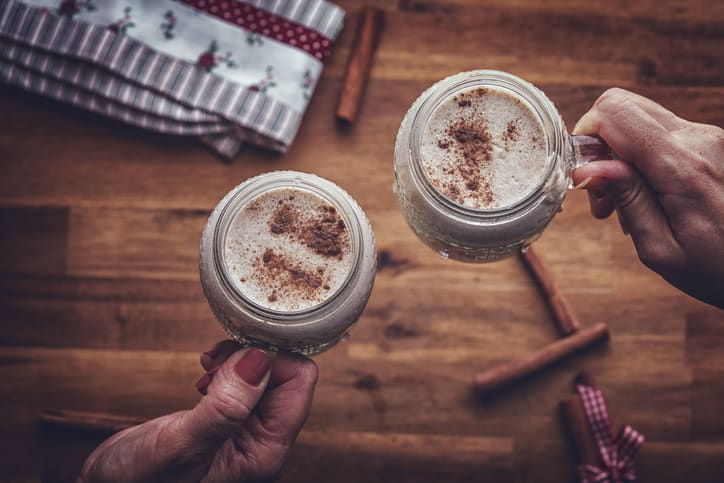Eggnog is one of those things you either absolutely love or can’t stand. The festive holiday drink is made of eggs, sugar, milk, cream, nutmeg, and sometimes alcohol, and it’s basically synonymous with Christmas. Still, as popular as it is, you can’t help but wonder where eggnog came from. Who thought that drinking egg yolks would be delicious? Who imagined that drinking something like this mixture, and adding rum or bourbon to it, would be a great idea? And who agreed that it was?! There are way too many questions that come with this divisive drink, and you might want to know the answers before you chug down a large glass of the stuff during your holiday.
As with many popular foods and drinks out there, there are great versions of eggnog and terrible ones. You can find eggnog in cartons sold by the thousands at your local grocery store, you can buy it to-go pretty much anywhere around the month of December, and you can sometimes order it at a bar or restaurant. The eggnog you buy that is commercially packaged might be drinkable, but it’s probably not fantastic. Homemade eggnog is, supposedly, where it’s at. But where did the tradition even come from?!
While we don’t know the exact origins of eggnog, Time says that many historians agree that it came from the early medieval British drink called “posset,” a hot, milky, ale-like drink. By the 13th century, monks were drinking posset with eggs and figs.
Because these were foods of the wealthy back then, eggnog was used in celebratory toasts.
Alcohol was originally added to eggnog not just for the taste, but for safety. According to Eater, early eggnog from Medieval Europe included a distilled liquor. Alcohol was said to be safer than straight milk and was often added to dairy to kill harmful bacteria (this is why modern recipes made with actual eggs recommend letting it sit for a few days or weeks).
It wasn’t until the 1700s that eggnog became popular in America. American colonists added rum from the Caribbean, and since rum was so much less expensive than other liquors, it became very popular.
Historians aren’t exactly sure of why eggnog became a holiday drink, but they believe it’s because back in the day, spices were a luxury and were most often used around special occasions. The winter months were also good for eggnog because the cold air helped milk and eggs stay cool during the time before refrigeration.
As for where the strange name came from (seriously, who thought of eggnog?!), historians aren’t sure. Some say “nog” comes from “noggin,” meaning wooden cup, or “grog,” a strong beer. The first known use of “eggnog” was around 1775, making many believe it was an American invention influenced by the English.
Getting all Christmassy #eggnog #yuletide. Party time all through December. pic.twitter.com/sem3fcpK4H
— The Perfect Plum (@plumcateringbtn) December 16, 2018
Even George Washington was into eggnog. Time says he had his own eggnog recipe that was heavy on the alcohol and included rum, sherry, and whiskey.

In fact, Americans were so into eggnog that it once caused a riot in 1826, according to PBS. Up until then, cadets at West Point had an annual tradition of having spiked eggnog during Christmas parties. A newly appointed superintendent then forbade alcohol, and so cadets had to smuggle it. When they got caught, the night got violent, 19 cadets were expelled, and… West Point no longer has a large holiday celebration. It was known as the Eggnog Riot.

Still, eggnog continued to be a favorite among soldiers. According to Forbes, a 1859 editorial in “The Chicago Press and Tribune” said, “Eggnog has ruled the country today. It is a famous drink in public and private houses in Washington on Christmas, and some of the members, in spite of it, reached the house today at noon, and some, in consequence of it, did not get there at all.”
Because of the alcohol in eggnog, it continued to be linked to many fights and even stabbings of people who got into trouble after having way too much of it.
I reaffirmed today that commercial #eggnog is pretty awful.
— Donna Freedman (@DLFreedman) December 16, 2018
Which, I guess, makes me an eggnogstic. pic.twitter.com/oCdAUyUtgX
President Dwight Eisenhower also had his own eggnog recipe, which apparently called for one dozen egg yolks, one pound of granulated sugar, one quart of bourbon, one quart of coffee cream, and one quart of whipping cream, according to The Atlantic.

Forbes says that in 1940s, nonalcoholic eggnog began getting more popular. You could even get non-alcoholic eggnog delivered with your milk, if you wanted to.
[video_quote pvideo=”Yj9TX2v8″ video=”Yj9TX2v8″ text=””]
Since eggnog became popular in the Americas, many different versions popped up. In Mexico, a version of the drink was known as “rompope.”
In Puerto Rico, it’s “coquito,” with coconut milk. In Peru, they made it with a Peruvian brandy called pisco.
Its popularity isn’t going anywhere. Slate says that sales of eggnog have quadrupled in the last 50 years, despite the fact that it’s only available two months of the year. Even though it doesn’t need to be seasonal, it is, and sales immediately drop once the holiday season is over.
Today, most eggnog recipes are not made with eggs, or they’re made with very small amounts, due to FDA regulations (you definitely don’t want people getting sick from eggnog). Traditional recipes use eggs, which may be why they’re said to be the best.
There’s also no shortage of eggnog variations, of course. There is eggnog ice cream, eggnog coffee, eggnog protein powder, pumpkin eggnog, vanilla eggnog, eggnog drinks at Starbucks… the list goes on.
Just hopped on the #eggnog express @MarbleSlabCan pic.twitter.com/VE4zgicfHI
— Jay Eatz (@jay_eatz) December 17, 2018
However, the traditional nog will probably always be everyone’s favorite. Cheers!

